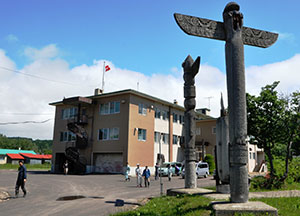The Nakagawa Experimental Forest (ca. 19,000 ha) was established in 1902 as the second Fundamental Forest of Sapporo Agricultural College, the predecessor of Hokkaido University, and is located in administrative districts of Nakagawa Town and Otoineppu Village, in northern Hokkaido. The soil is composed mainly of Cretaceous sedimentary strata, with some areas of serpentine rock. The elevation ranges from 20 to 716 meters, and the slope is generally steep. The forest consists mainly of a mixed natural forest and a few stands of akaezo spruce (Picea glehnii) in the serpentinite zone. The Siberian dwarf pine (Pinus pumila) zone can be found at higher elevations. Since 1967, a long-term tree-census has been conducted at a 110 ha site. The primary objective is to establish appropriate methods for selective cutting, which allows for sustainable yields of timber. Recently, this large-scale study has begun to be used for remote sensing studies. To understand the effect of climate change on forest ecosystems, we conduct field manipulations that warm mature trees (20 m in height) and change snow-melt timing of forest stands. In the Nakagawa Experimental Forest, a bypass of the National Highway Route 40 (about 20 km) is being built, and soil retention dams are being improved to add a fishway at present. Thus research to detect the impact of these developments and to create new techniques to reduce environmental load is also being conducted.
Nakagawa Experimental Forest Forest Research Station

- ADDRESS
- Otoineppu, Otoineppu-mura, Hokkaido, 098-2501, JAPAN
- TEL
- +81-1656-5-3216
- FAX
- +81-1656-5-3218
- nakagawa [at] fsc.hokudai.ac.jp









